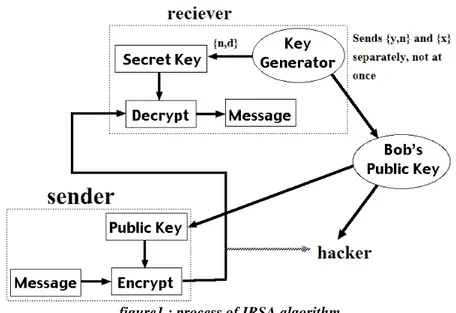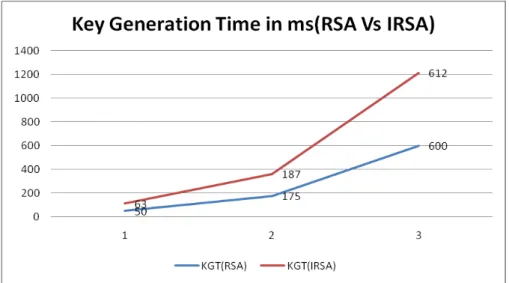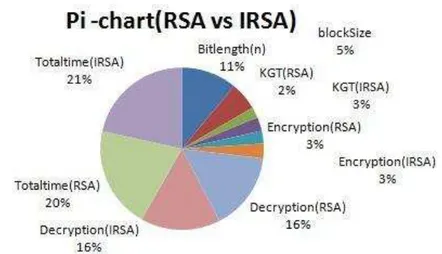American Journal of Engineering Research (AJER)
e-ISSN : 2320-0847 p-ISSN : 2320-0936
Volume-4, Issue-1, pp-143-149
www.ajer.org
Research Paper Open Access
Improved RSA cryptosystem based on the study of number
theory and public key cryptosystems
Israt Jahan, Mohammad Asif, Liton Jude Rozario
Department of Computer Science & Engineering, Jahangirnagar University, Savar, Dhaka, Bangladesh Department of Computer Science & Engineering, Jahangirnagar University, Savar, Dhaka, Bangladesh Department of Computer Science & Engineering, Jahangirnagar University, Savar, Dhaka, Bangladesh
ABSTRACT:
Security is required to transmit confidential information over the network. Security is also demanding in wide range of applications. Cryptographic algorithms play a vital role in providing the datasecurity against malicious attacks.RSA algorithm is extensively used in the popular implementations of Public
KeyInfrastructures. In asymmetric key cryptography, also called Public Key cryptography, two different keys
(which forma key pair) are used. One key is used for encryption and only the other corresponding key must be
used for decryption.No other key can decrypt the message – not even the original (i.e. the first) key used for
encryption. In this paper, we have proposed an improved approach of RSA algorithm using two public key pairs
and using some mathematical logicrather than sending one public key directly.Because if an attacker has an
opportunity of getting the public key componet theycan find private key value by brute force search.
General Terms: Cryptography, network security
KEYWORDS: IRSA, RSA, security, cryptography
I.
INTRODUCTION
Number theory may be one of the “purest” branches of mathematics, but it has turned out to be one of
the most useful when it comes to computer security. Sensitive data exchanged between a user and a Web site needs to be encrypted to prevent it from being disclosed to or modified by unauthorized parties. The encryption must be done in such a way that decryption is only possible with knowledge of a secret decryption key. The decryption key should only be known by authorized parties.
In traditional cryptography, such as was available prior to the 1970s, the encryption and decryption operations are performed with the same key. This means that the party encrypting the data and the party decrypting it need to share the same decryption key. Establishing a shared key between the parties is an interesting challenge. If two parties already share a secret key, they could easily distribute new keys to each
other by encrypting them with prior keys. But if they don’t already share a secret key, how do they establish the
first one? This challenge is relevant to the protection of sensitive data on the Web and many other applications like it. This line of thinking – in pre-Web terminology – prompted two Stanford University researchers,
Whitfield Diffie and Martin Hellman, to write a landmark paper, “New Directions in Cryptography” in 1976 [6].
The paper suggested that perhaps encryption and decryption could be done with a pair of different keys rather than with the same key. The decryption key would still have to be kept secret, but the encryption key could be made public without compromising the security of the decryption key. This concept was called public-key cryptography because of the fact that the encryption key could be made known to anyone.
The full public-key method would come a year later as an application of another famous problem, integer factorization[11].
II.
RSA CRYPTOSYSTEMwith roughly twice as many digits as the prime factors.
The public key information includes n and a derivative of one of the factors of n; an attacker cannot determine the prime factors of n (and, therefore, the private key) from this information alone and that is what makes the RSA algorithm so secure.
2.1
RSA Key Generation Algorithm:
1. Generate two large random primes, p and q, of approximately equal size such that their product n = pq is of the required bit length, e.g. 1024 bits.
2. Compute n = pq and (φ) phi = (p-1)(q-1).
3. Choose an integer e, 1 < e < phi, such that gcd(e, phi) = 1.
4. Compute the secret exponent d, 1 < d < phi, such that ed ≡ 1 (mod phi).
5. The public key is (n, e) and the private key is (n, d). Keep all the values d, p, q and phi secret.
n is known as the modulus.
e is known as the public exponent or encryption exponent or just the exponent. d is known as the secret exponent or decryption exponent.
2.2 Encryption Algorithm Sender A does the following:-
1. Obtains the recipient B's public key (n, e).
2. Represents the plaintext message as a positive integer m 3. Computes the cipher text c = me mod n.
4. Sends the cipher text c to B.
2.3 Decryption Algorithm Recipient B does the following:-
1. Uses his private key (n, d) to compute m = cd mod n. 2. Extracts the plaintext from the message representative m.
III.
NUMBER THEORY BEHIND RSA: III.1 Prime Generation and Integer FactorizationTwo basic facts and one conjecture in number theory prepare the way for today’s RSA public-key cryptosystem.
FACT 1. Prime generation is easy: It’s easy to find a random prime number of a given size.
This is a result of two other points: Prime numbers of any size are very common, and it’s easy to test whether a number is a prime – even a large prime.
According to the Prime Number Theorem, the expected number of candidates to test will be on the order of ln x (the natural logarithm of x) where x is a typical number of the intended size.
“Large” in the cryptographic context typically means 512 bits (155 decimal digits) or more.
FACT 2. Multiplication is easy: Given p and q, it’s easy to find their product, n = pq.
to p-1 and q-1, meaning the following equation has to be satisfied: gcd(e,(p-1).(q-1))=1
The encryption and decryption operations in the RSA public-key cryptosystem are based on two more facts and one more conjecture:
FACT 4.Modular exponentiation is easy: Given n, m, and e, it’s easy to compute c = me mod n.
The value me mod n is formally the result of multiplying e copies of m, dividing by n, and keeping the remainder. This may seem to be an expensive computation, involving e-1 multiplications by m with increasingly large intermediate results, followed by a division by n. However, two optimizations make the operation easy:
1. Multiplying by an appropriate sequence of previous intermediate values, rather than only by m, can reduce the number of multiplications to no more than twice the size of e in binary.
2. Dividing and taking the remainder after each multiplication keeps the intermediate results the same size as n [2].
FACT 5. Modular root extraction – the reverse of modular exponentiation – is easy given the prime factors: Given n, e, c, and the prime factors p and q, it’s easy to recover the value m such that c = me mod n.
The value m can be recovered from c by a modular exponentiation operation with another odd integer d between 3 and n-1. In particular, for this d, the following holds for all m:
m = (me)d mod n .
This integer d is easy to compute given e, p, and q.
CONJECTURE 6. Modular root extraction is otherwise hard: Given only n, e, and c, but not the prime factors, it appears to be quite hard to recover the value m.
We will want to compute d from e, p and q , where d is the multiplicative inverse of d. It means
e.d=1(mod Ø(n))
IV.
PROPOSED IRSA(IMPROVED RSA)ALGORITHMRSA is a block cipher in which the plaintext and cipher text are integers between 0 and n- 1 for some n.
Encryption and decryption are of the following form, for some plaintext block M and cipher text block C: C = My/xmod n
M = Cdmod n = (My/x)dmod n.
Both sender and receiver must know the values of n, y and x only the receiver knows the value of d.
IV.1 Process of Encryption and Decryption:
This is a public key encryption algorithm with a public key of KU = {y,n},{x} and a private key of KR = {d,n}.
For this algorithm to be satisfactory for public-key encryption, the following requirements must be met: 1. It is possible to find values of y, x, d, n such that (My/x) d= M mod n for all M<n.
2. It is relatively easy to calculate My/x and Cd for all values of M <n.
figure1 : process of IRSA algorithm
IV.2 Computational Steps:
• Begin by selecting two prime numbers, p and q, and calculating their product n, which is the modulus for
encryption and decryption.
• Next, we need the quantity φ(n) referred to as the Euler totient of n, which is the number of positive integers
less than n and relatively prime to n.
• Then select an integer e that is relatively prime to φ(n) (i.e., the greatest common divisor of e and φ(n) is 1).
• Select two numbers x and y such that y=xe
• Using this numbers formulate two public key {y,n},{x}
• Finally, calculate d as the multiplicative inverse of e (which is public key in normal RSA), modulo φ(n).
• Suppose that user A has published its public key and that user B wishes to send the message M to A.
• Then B calculates C = My/x(mod n) and transmits C.
V.
EXPERIMENTAL RESULTSIn order to justify the performance we used different modulus length(256 bits, 512 bits,1024 bits)
and the block sizes (128 bits,256 bits,512 bits,1024 bits). The two following table shows the experimental results of RSA and IRSA respectively.
TABLE 1: Table of experimental result on RSA bitlength(n) blocksize in
bits
key generation(x) MS
Encryption time(y) MS
Decryption time(z) MS
Total time t=x+y+z MS
256 128 50 59 360 469
512 256 175 88 909 1172
figure 2: Key generation time comparison of RSA and IRSA in ms
From the above figure it is clear that the key generation time in IRSA is greater than RSA key generation time as IRSA requires additional x and y to be generated.
figure 3: Encryption time of RSA and IRSA
The above figure shows the encryption time of RSA and IRSA. As it is seen from the figure that IRSA takes more time than RSA to encrypt(in mili second),but the difference is very few.
The following figure shows the decryption time of RSA and IRSA and it is also of similar behaviour like figure 5.2, that is decryption time of IRSA is more than RSA.
The total time comparison(including key generation,encryption and decryption)of RSA and IRSA is below:
figure 5: Total time comparison of RSA and IRSA in ms (key generation+encryption+decryption) The overall comparison between RSA and IRSA can be better seen from the following pi chart.
figure 6: pi-chart of overall comparison between RSA and IRSA
The table below shows the comparison between RSA and IRSA
TABLE 3: Table of comparison between RSA and IRSA RSA IRSA
Use only one public key Use two public key
REFERENCES
[1] Shilpa M Pund, Chitra G Desai. Implemantation of RSA using Mersenne Prime. International Journal of Networking & Parallel Computing. Volume 1, Issue 3, Dec 2012-Jan 2013.
[2] S. Sharma, J.S. Yadav, P. Sharma. Modified RSA Public Key Cryptosystem Using Short Range Natural Number Algorithm. International Journal of Advanced Research in Computer Science and Software Engineering, volume 2, Issue 8, August 2012 [3] P.Saveetha,S. Arumugam, Study on improvement in RSA algorithm and its implementation.Volume 3, Issue 6,7,8 ,2012. [4] P.S.Yadav, P. Sharma, Dr. K. P. Yadav, Implementation of RSA algorithm using Elliptic Curve algorithm for security and
performance enhancement, International Journal of Scientific & Technology Research, Volume 1, Issue 4, May 2012. [5] D. Pugila, H. Chitrala, S. Lunawat, P.M. Durai Raj Vincent, An Efficient Encryption Algorithm Based On Public Key
Cryptography. International Journal of Engineering and Technology, Volume 5 No 3,Jun-2013.
[6] Burt Kaliski, “The Mathematics of the RSA Public-key Cryptosystem RSA Laboratory.
[7] Fatema Chowdhury, Munibur Rahman Chowdhury, “Essentials of Number Theory”,Pi Publications,Dhaka Bangladesh.2005
[8] B.A. Forouzan, Cryptography & Network Security, Tata Mcgraw Hill publishing company limited, 2010.
[9] T.H. Cormen, C.E. Leiserson, R.L. Rivest, C. Stein, “Introduction to Algorithm”, 2nd edition, MIT press,2002. [10] A.S. Tanenbaum, “Computer Networks”, 4th edition, Prentice Hall of India, 2007-2008.
[11] B.R. Ambedkar, S.S. Bedi, A New Factorization Method to Factorize RSA Public Key Encryption, International Journal of


